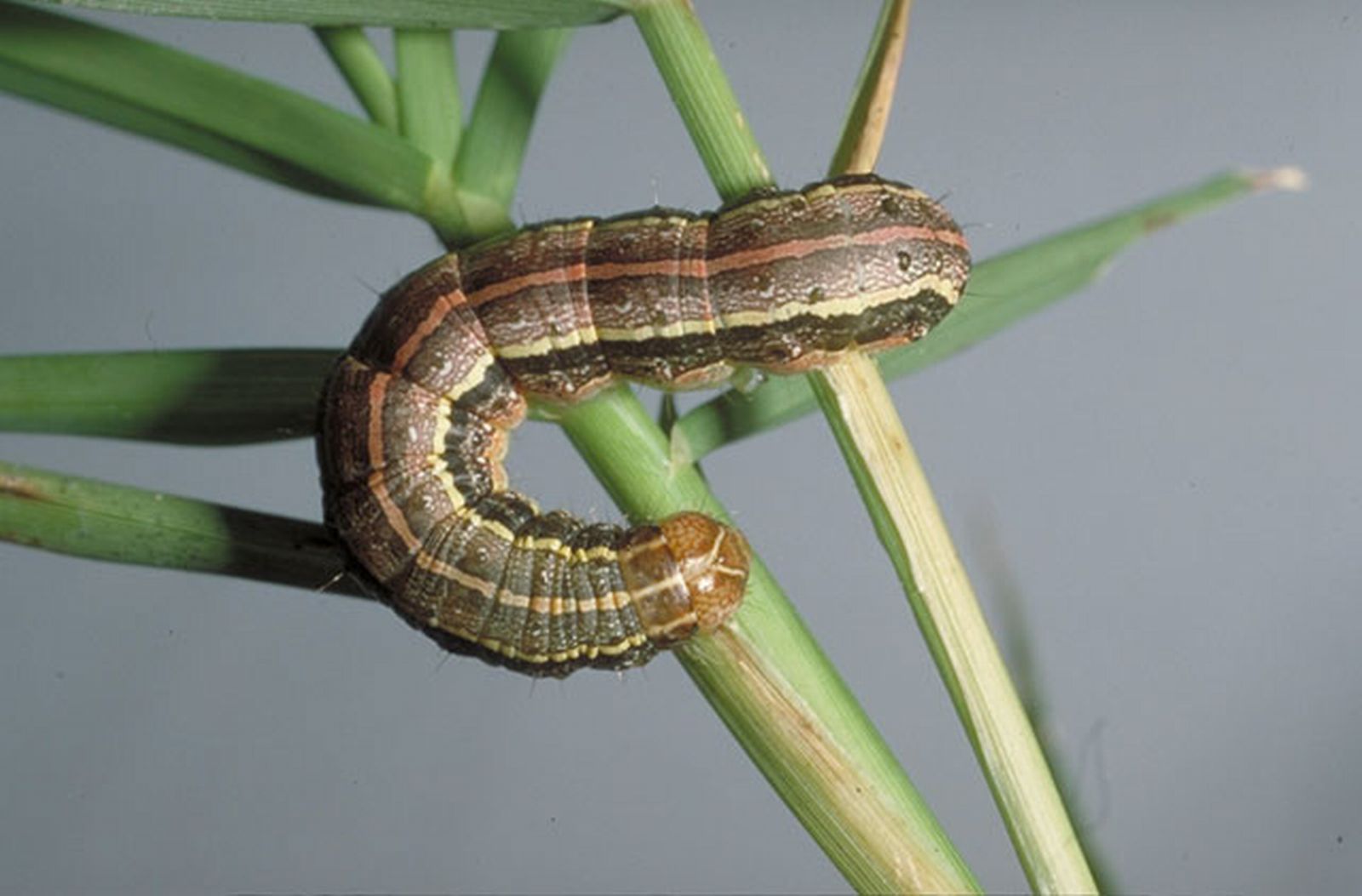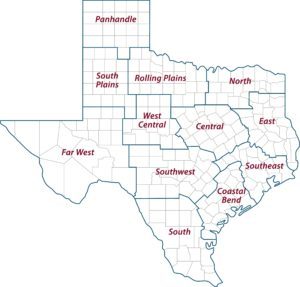Texas Forage Producers Should Beware of Fall Armyworms
Texas hay and forage producers should be prepared to protect their pastures from fall armyworms, according to a Texas A&M AgriLife Extension Service expert.

In large numbers, fall armyworms can be devastating to hayfields and pastures due to their appetite for green grass crops. (Texas A&M AgriLife Extension photo by Dr. Bart Drees)
Vanessa Corriher-Olson, Ph.D., AgriLife Extension forage specialist, Overton, said 2019 has been a good year for hay production, but unchecked armyworms can still destroy a last cutting, stockpiled forages meant for fall and winter grazing, or young winter pastures, including ryegrass.
“It’s been very dry for a while now, so I would anticipate armyworms to emerge in destructive numbers following any significant rainfall,” she said. “It’s important for producers to be prepared at this time of year as we move into fall, which is when we see population increases of armyworms.”
Corriher-Olson said it is critical that producers have pesticides ready for applications as soon as armyworm numbers near three or more armyworms per square foot. Armyworms in those numbers should be treated immediately. Armyworms in the last two or three days of their larval stage consume 85% of their diet.
Corriher-Olson said armyworms will continue to be a threat to forages until the first freeze.
“Diligent scouting is important if you want to preserve a last cutting or stockpiled forages meant for winter,” she said. “But producers should also be mindful that armyworms will feed on winter forages like small grains and ryegrass. They prefer high-quality forages, so going into fall they will choose seedlings over Bermuda grass.”
Pest and path of destruction
Armyworm moths can lay up to 2,000 eggs that hatch in two to three days, according to a 2018 report by Allen Knutson, Ph.D., AgriLife Extension entomologist, Dallas. There are four to five generations per year.
Corriher-Olson said armyworm caterpillars are picky eaters that prefer high-quality, fertilized forage typically found on fields maintained for hay production. They are a common pest of Bermuda grass, sorghum, corn, wheat, rye grass and many other crops in north and central Texas.
Producers should scout each morning for armyworms, she said. Armyworms are night feeders and try to avoid daytime temperatures.
Armyworms are green, brown or black in color and can be identified by the white inverted Y on their head. They can grow up to 1 inch in length when mature.
The pest got its name because they appear to march across hay fields, consuming the grass in their path.
Corriher-Olson recommends insecticides labeled for armyworm control in pastures and hayfields. She said applicators should always follow all label instructions on pesticide use and restrictions.
Fast action
Fast action is paramount when it comes to reducing armyworm damage, so pesticides should be on hand, she said. Producers can save unused pesticides for armyworm or grasshopper problems in 2020 with proper storage of chemicals.
“You don’t need to wait a day if their numbers are at threshold,” she said. “They are going to do a lot of damage quickly. If you find them in the morning, spray that day.”
AgriLife Extension has a number of resources with more information about armyworms, including AgriLife Extension Bookstore and Forage Fax.
Corriher-Olson said new and seasoned forage producers have been on edge regarding armyworms since last year when outbreaks were widespread and impacted production during a poor forage and hay season. She said producers shouldn’t fear the pest but should be vigilant if they want to defend their pastures.
“A lot of people were worried last year because armyworm populations exploded,” she said. “There was panic among producers, but did that panic turn into preparedness for this season? I don’t know.”
AgriLife Extension district reporters compiled the following summaries:

The 12 Texas A&M AgriLife Extension Districts
CENTRAL: Parts of the district received 1-2 inches of rainfall and cooler temperatures. The forecast called for higher temperatures. Pecan conditions remained good, and cooler weather and rainfall should help the crop finish. Corn and grain sorghum harvests were mostly complete, and preparations for small grains were in progress. Pastures were in poor condition due to lack of rainfall. Cotton defoliation began on early planted fields. Cattle were in good condition, and stock pond levels were holding steady. Nearly all counties reported short soil moisture levels. Overall, rangeland, pasture and crop conditions were fair.
ROLLING PLAINS: Most of the district was hot and dry with some areas receiving much-needed rain. Dryland cotton fields were in fair condition. All fields were maturing bolls with most reaching the cutout stage. Rain was still needed to increase boll size and quality. Pastures and tanks continued to decline as hot and windy days depleted any moisture received quickly. Wheat producers started to prepare fields with fertilizer.
COASTAL BEND: Weather was hot and dry with some isolated showers. Post-harvest field operations continued with disking and stalk destruction. Cotton harvest continued. Rice and corn harvests were complete. Rangelands and pastures were suffering from lack of rain, and many cattle producers were feeding hay as forages became more limited. Livestock were in good condition, but some producers were weaning early.
EAST: The district received spotty showers in most areas. Parts of Cherokee County received as much as 7 inches of rain. Many areas still needed rain. Pasture and rangeland conditions were fair to good. Subsoil and topsoil conditions were adequate to short. Hay production was still going where possible. Vegetable production was beginning to slow down. Livestock were doing fair to good. Wild pigs continued to cause damage. Armyworms were reported in some areas. Sabine County reported armyworms, and Bermuda grass stem maggots had wiped out any hope of a last cutting in several meadows.
SOUTH PLAINS: Cotton producers continued to reduce water for this year’s cotton crop to let it finish maturing. Some cotton bolls were starting to open. Scattered showers brought much- needed rain to parts of the district. Reports of rainfall ranged from a trace to almost 1 inch. Mature pumpkins were being harvested. The local grain elevators were busy with harvested corn. Cattle were in good condition.
PANHANDLE: A little rainfall and lower temperatures were reported in northern areas of the panhandle. Pasture and rangeland conditions were fair to poor. Sorghum was heading out. Soybeans were in fair condition, and most had set pods. Corn was in fair condition. Subsoil was short to very short in northeastern parts of the district and adequate in the southern areas. The topsoil was short throughout the district.
NORTH: Soil moisture was mostly adequate to short throughout the district. Reported rainfall amounts were 1-3 inches. Temperatures were in the upper 90s. Wheat and corn crops were good this season, averaging around 60-70 bushels per acre and 140-150-bushels per acre, respectively. Sorghum looked good so far with early fields making 3,500-5,500 pounds per acre. Farmers needed low humidity to finish harvest. Hay harvesting continued though production slowed down due to the lack of rainfall. The cow/calf sector was good with calves making decent gains so far. Horn flies were a problem but not as bad as prior years. Armyworms were active in fields.
FAR WEST: The temperature high was 110 degrees with a low of 60 degrees. Thunderstorms produced up to 2 inches of rain. Dryland cotton was declining under high temperatures. Most irrigated cotton looked good and close to start making bolls. Pastureland was dry, and fires were a concern. More cow/calf producers shipped weaned calves. Rangeland and livestock conditions remained fair to good, but some supplemental feeding started. Cattle looked good despite hot and dry conditions. Hay producers moved hay from fields and did not anticipate another cutting. Alfalfa farmers continued to receive light rain which hurt quality. Pecans looked promising and were beginning to really show their loads on trees as nuts filled out. Some growers sprayed for black aphids.
WEST CENTRAL: Spotty showers fell around the district. Cotton fields were hanging on and were in full bloom stage. Rangelands and pastures were severely drought stressed and worsening. Grain sorghum harvest neared completion, and yields were average or below average. Forage and hay pastures showed drought stress. Field preparations for fall planting were underway. The pecan crop continued to progress well. Water levels in smaller stock tanks were getting low, but bigger tanks were in good shape. The cattle market improved on all classes of calves and yearlings. Pairs and bred cows, stocker and feeder steers, and heifers sold steady.
SOUTHEAST: Rainfall was needed badly. Pastures were beginning to brown in many areas. Jefferson County received scattered rain showers which slowed the rice harvest. Hay was not harvested due to sporadic weather. Grimes County remained in a burn ban. Mosquitoes were a major problem around ponds despite dry conditions. Rangeland and pasture ratings varied from excellent to very poor with fair being most common. Soil moisture levels ranged from adequate to very short with short being most common.
SOUTHWEST: The weather continued to be hot and dry with weekend showers that produced 0.30 of an inch of rain in Sutton County and spotty showers in other areas. Pastures continued to decline due to high temperatures and lack of rain. Potential wildfire threats continued across the district. Heat stress was becoming a concern for livestock. Livestock conditions ranged from fair to good. Supplemental feeding continued. Corn harvest neared completion. Winter wheat fields were ready to plant.
SOUTH: Hot, dry weather conditions continued with short to very short soil moisture levels. Daily temperatures were at or above 100 degrees. Peanut fields were maturing under irrigation. Producers started to defoliate cotton fields. Bermuda grass and haygrazer fields were under irrigation. Pasture and rangeland conditions were poor and continued to decline due to lack of rainfall and very hot temperatures. Vegetables like watermelons and cantaloupes were under irrigation. Gins in Zavala County began processing cotton, and cotton harvest was nearing completion in Jim Wells County. Corn and sorghum harvest were complete across the district. Oat planting preparations were active this past week, and pecans made good progress as well. Fall vegetable field preparations were active. Zapata County reported up to 3 inches of rainfall, and more rainfall was in the forecast. Southern parts of Starr County reported 2-4 inches of rain. Most producers were providing supplemental feeding and hauling water. Fire risks were high, especially in areas not grazed by cattle. Burn bans were in place. The governor declared Duval, Jim Hogg, Webb and Zapata counties drought disaster areas.
Source: Texas AgriLife Today
